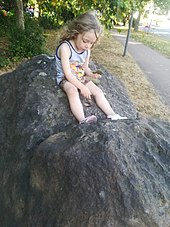Horkenstein
The Horkenstein is a rock weighing around 20 tons , which was in Dahlhausen until 1876 and was then brought to Hattingen . It is believed that it was used in early history either to determine the solstices or as a sacrificial stone for the sacrifice of people or animals (a "blood groove" indicates this). Today it is located at the intersection of Martin-Luther-Strasse and August-Bebel-Strasse at the bus station on the edge of the old town of Hattingen.
The stone is four meters long, one meter wide and 1.5 meters high. It is not a boulder, because it consists of local Ruhr sandstone .
history
The Horkenstein was originally located on a right-hand hill in the Ruhr Valley , on the Groten or Grotenberg , southeast of the former United Dahlhauser Tiefbau colliery . Immediately next to it, the Haimbecke flows through a Siepen into the Ruhr.
The stone was first mentioned in writing between 1711 and 1721.
According to a folk legend, the devil took the stone from the Orient to kill Saint Liudger , but dropped it here when he was banned by a missionary with the cross. According to another legend, Roman prisoners of war were executed here after the Varus Battle by a giant named Horkus . There are various attempts to interpret the name itself, such as Högr , old Norse for “sanctuary”, or Eorcanstan , Anglo-Saxon for “holy stone”, or horkos , ancient Greek for “oath”. Sometimes a ghost figure is said to have shown itself here at night at the old location near the Wihekel (“consecrated oaks”).
In 1876, the then owner Heinrich Eggemann , a timber merchant and innkeeper, gave the stone to the Hattingen bailiff, shoemaker . He had him brought on a sledge to the garden of the office in Hattingen-Winz .
In 1984 local historians suggested a return to the old place, which is still characterized by forests and meadows today. The Hattingen council, however, asked the Hattingen local home nurse Heinrich Eversberg for an opinion. This in turn recommended the relocation of the stone monument to the city center of Hattingen. Today the stone in Hattingen is hardly noticed, without explanation or historical context, at a traffic light.
The Horkenstein in literature
- Wikisource: The poem Der Horkenstein from the volume of poems Was die Ruhr mir sang (1909) by Heinrich Kämpchen
literature
- Johannes Groht: Menhirs in Germany. State Office for Monument Preservation and Archeology Saxony-Anhalt, Halle (Saale) 2013, ISBN 978-3-943904-18-5 , pp. 239–241, 245–247.
- O. Höckmann: The menhir at Kaiserwerth. In: Römisch-Germanisches Zentralmuseum Mainz (ed.): Essen, Düsseldorf, Duisburg (= guide to prehistoric and early historical monuments. Volume 15) Mainz 1969.
- Heinrich Kämchen: The Horkenstein. In: What the Ruhr sang to me. Bochum 1909, p. 25.
- Wolfhard Schlosser: The Horkenstein from an astronomical point of view. In: Dirk Sondermann (ed.): Hattinger saga book. Bottrop 2007, pp. 106-109.
- Dirk Sondermann: Ruhr sagas. From Ruhrort to Ruhrkopf. Bottrop 2005.
Individual evidence
- ↑ https://www.derwesten.de/staedte/hattingen/der-gende-mythos-id6552252.html
- ↑ Joseph Esser: Monuments of the Ice Age in the Bochum landscape . In: Heimatbuch Bochum, Volume 3, 1930
- ↑ Dirk Sondermann : Ruhr sagas. From the mouth to the source. , Bottrop, 2nd edition 2006, ISBN 3-922750-60-5
Coordinates: 51 ° 23 ′ 52.8 " N , 7 ° 10 ′ 47" E


